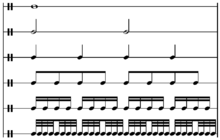Whole note


In music, a whole note (American) or semibreve (British) is a note represented by a hollow oval note head, like a half note (or minim), and no note stem (see Figure 1). Its length is equal to four beats in 4/4 time. Most other notes are fractions of the whole note; half notes are played for one half the duration of the whole note, quarter notes (or crotchets) are each played for one quarter the duration, etc.
A whole note lasts half as long as a double whole note (or breve—hence the British name, semibreve), and twice as long as a half note, or minim. The symbol is first found in music notation from the late thirteenth century (Morehen and Rastall 2001).
A related symbol is the whole rest (or semibreve rest), which usually denotes a silence for the same duration. Whole rests are drawn as filled-in rectangles hanging under the second line from the top of a musical staff.
Other lengths
The whole note and whole rest may also be used in music of free rhythm, such as Anglican chant, to denote a whole measure, irrespective of the time of that measure. The whole rest can be used this way in almost all or all forms of music.
Etymology
The whole note derives from the semibrevis of mensural notation, and this is the origin of the British name. The American name is a calque of the German ganze Note.
The names of this note (and rest) in different languages vary greatly:
| Language | note name | rest name |
|---|---|---|
| Catalan | rodona | silenci de rodona |
| Arabic | البيضاء | سكتة البيضاء |
| Estonian | täisnoot | täispaus |
| Chinese (中文) | 全音符 | 全休止符 |
| Danish | helnode | helnodepause |
| Dutch | hele noot | hele rust |
| French | ronde | pause |
| German | ganze Note | ganze Pause |
| Greek | olokliro (ολόκληρο) | pafsi oloklirou (παύση ολοκλήρου) |
| Italian | semibreve | pausa di semibreve |
| Japanese | 全音符 (zen onpu) | 全休符 (zen kyūfu) |
| Korean | 온음표 | 온쉼표 |
| Lithuanian | pilnoji nata | pilnoji pauzė |
| Portuguese | semibreve | pausa de semibreve |
| Polish | cała nuta | pauza całonutowa |
| Romanian | notă întreagă | pauză de nota intreaga |
| Russian | целая нота | целая пауза |
| Serbian | cela nota / цела нота | cela pauza / цела пауза |
| Spanish | redonda | silencio de redonda |
| Swedish | helnot | helpaus |
| Thai | โน๊ตตัวกลม | ตัวหยุดตัวกลม |
| Vietnamese | nốt tròn | lặng tròn |
| Welsh | hannerbrif | saib yr hannerbrif |
The Catalan, French and Spanish names for the note (meaning "round") derive from the fact that the semibrevis was distinguished by its round stemless shape, which is true as well of the modern form (in contrast to the double whole note or shorter values with stems). The Greek name means "whole". Chinese, Japanese, Korean, and Vietnamese names mean "whole note".
See also
References
- Morehen, John, and Richard Rastall. 2001. "Semibreve". The New Grove Dictionary of Music and Musicians, second edition, edited by Stanley Sadie and John Tyrrell. London: Macmillan Publishers.
| ||||||||||||